Chemical Characterization, Source Identification, and Health Risk Assessment of Atmospheric Fine Particulate Matter in Winter in Hangzhou Bay
Abstract
:1. Introduction
2. Materials and Methods
2.1. Site Description
2.2. Component Analysis
2.2.1. Weighing Procedure and PM2.5 Sampling
2.2.2. OC and EC Analysis
2.2.3. WSIIs Analysis
2.2.4. Heavy Metal Analysis
2.3. Data Analysis
2.3.1. PMF
2.3.2. Backward Trajectory and Clustering
2.3.3. PSCF and CWT Analysis
2.4. Health Risk Assessment Methods
3. Results and Discussion
3.1. Overview of PM2.5
3.2. Sources and Regional Transport of PM2.5
3.2.1. Source Apportionment
3.2.2. Back Trajectory Cluster and Regional Transport
3.3. Health Risk Assessment
3.3.1. Health Risk Assessment
3.3.2. Health Risk Associated with Sources
4. Conclusions
Supplementary Materials
Author Contributions
Funding
Institutional Review Board Statement
Informed Consent Statement
Data Availability Statement
Conflicts of Interest
References
- Charlson, R.J.; Lovelock, J.E.; Andreae, M.O.; Warren, S.G. Oceanic phytoplankton, atmospheric sulphur, cloud albedo and climate. Nature 1987, 326, 655–661. [Google Scholar] [CrossRef]
- Chuang, M.-T.; Chen, Y.-C.; Lee, C.-T.; Cheng, C.-H.; Tsai, Y.-J.; Chang, S.-Y.; Su, Z.-S. Apportionment of the sources of high fine particulate matter concentration events in a developing aerotropolis in Taoyuan, Taiwan. Environ. Pollut. 2016, 214, 273–281. [Google Scholar] [CrossRef] [PubMed]
- Yao, L.; Yang, L.X.; Yuan, Q.; Yan, C.; Dong, C.; Meng, C.P.; Sui, X.; Yang, F.; Lu, Y.L.; Wang, W.X. Sources apportionment of PM 2.5 in a background site in the North China Plain. Sci. Total Environ. 2016, 541, 590–598. [Google Scholar] [CrossRef] [PubMed]
- Huang, X.F.; Yun, H.; Gong, Z.H.; Li, X.; He, L.; Zhang, Y.H.; Hu, M. Source apportionment and secondary organic aerosol estimation of PM2.5 in an urban atmosphere in China. Sci. China Earth Sci. 2014, 57, 1352–1362. [Google Scholar] [CrossRef]
- Yuan, C.-S.; Wong, K.-W.; Tseng, Y.-L.; Ceng, J.-H.; Lee, C.-E.; Lin, C. Chemical significance and source apportionment of fine particles (PM2.5) in an industrial port area in East Asia. Atmos. Pollut. Res. 2022, 13, 101349. [Google Scholar] [CrossRef]
- Chang, Y.; Huang, K.; Xie, M.; Deng, C.; Zou, Z.; Liu, S.; Zhang, Y. First long-term and near real-time measurement of trace elements in China’s urban atmosphere: Temporal variability, source apportionment and precipitation effect. Atmos. Chem. Phys. 2018, 18, 11793–11812. [Google Scholar] [CrossRef]
- Zhang, X.Y.; Ji, G.X.; Peng, X.W.; Kong, L.Y.; Zhao, X.; Ying, R.R.; Yin, W.J.; Xu, T.; Cheng, J.; Wang, L. Characteristics of the chemical composition and source apportionment of PM2.5 for a one-year period in Wuhan, China. J. Atmos. Chem. 2022, 79, 101–115. [Google Scholar] [CrossRef]
- Lv, L.L.; Wei, P.; Hu, J.N.; Chen, Y.J.; Shi, Y.P. Source apportionment and regional transport of PM2.5 during haze episodes in Beijing combined with multiple models. Atmos. Res. 2021, 266, 105957. [Google Scholar] [CrossRef]
- Li, X.; Yan, C.Q.; Wang, C.Y.; Ma, J.J.; Li, W.X.; Liu, J.Y.; Liu, Y. PM2.5-bound elements in Hebei Province, China: Pollution levels, source apportionment and health risks. Sci. Total Environ. 2022, 806, 150440. [Google Scholar] [CrossRef]
- Xie, J.W.; Jin, L.; Cui, J.L.; Luo, X.S.; Li, J.; Zhang, G.; Li, X.D. Health risk-oriented source apportionment of PM2.5-associated trace metals. Environ. Pollut. 2020, 262, 114655. [Google Scholar] [CrossRef]
- Ma, L.X.; Li, B.; Liu, Y.P.; Sun, X.Z.; Fu, D.L.; Sun, S.J.; Thapa, S.; Geng, J.L.; Qi, H.; Zhang, A.P.; et al. Characterization, sources and risk assessment of PM2.5-bound polycyclic aromatic hydrocarbons (PAHs) and nitrated PAHs (NPAHs) in Harbin, a cold city in Northern China. J. Clean. Prod. 2020, 264, 121673. [Google Scholar] [CrossRef]
- Lu, S.L.; Yao, Z.K.; Chen, X.H.; Wu, M.H.; Sheng, G.Y.; Fu, J.M.; Paul, D. The relationship between physicochemical characterization and the potential toxicity of fine particulates (PM2.5) in Shanghai atmosphere. Atmos. Environ. 2008, 42, 7205–7214. [Google Scholar]
- Wang, X.F.; He, S.L.; Chen, S.C.; Zhang, Y.L.; Wang, A.H.; Luo, J.B.; Ye, X.L.; Mo, Z.; Wu, L.Z.; Xu, P.W.; et al. Spatiotemporal Characteristics and Health Risk Assessment of Heavy Metals in PM2.5 in Zhejiang Province. Int. J. Environ. Res. Public Health 2018, 15, 583. [Google Scholar] [CrossRef] [PubMed]
- Liu, P.P.; Lei, Y.L.; Ren, H.R.; Gao, J.J.; Xu, H.M.; Shen, Z.X.; Zhang, Q.; Zheng, C.L.; Liu, H.X.; Zhang, R.J.; et al. Seasonal Variation and Health Risk Assessment of Heavy Metals in PM2.5 during Winter and Summer over Xi’an, China. Atmosphere 2017, 8, 91. [Google Scholar] [CrossRef]
- Ge, D.F.; Nie, W.; Sun, P.; Liu, Y.L.; Wang, T.Y.; Wang, J.B.; Wang, J.P.; Wang, L.; Zhu, C.J.; Wang, R.X.; et al. Characterization of particulate organic nitrates in the Yangtze River Delta, East China, using the time-of-flight aerosol chemical speciation monitor. Atmos. Environ. 2022, 272, 118927. [Google Scholar] [CrossRef]
- Wong, Y.K.; Liu, K.M.; Yeung, C.; Leung, K.K.M.; Yu, J.Z. Measurement report: Characterization and source apportionment of coarse particulate matter in Hong Kong: Insights into the constituents of unidentified mass and source origins in a coastal city in southern China. Atmos. Chem. Phys. 2022, 22, 5017–5031. [Google Scholar] [CrossRef]
- Feng, X.X.; Feng, Y.L.; Chen, Y.J.; Cai, J.J.; Li, Q.; Chen, J.M. Source apportionment of PM2.5 during haze episodes in Shanghai by the PMF model with PAHs. J. Clean. Prod. 2021, 330, 129850. [Google Scholar] [CrossRef]
- Jia, J.P.; Deng, L.; Bi, C.J.; Jin, X.P.; Zeng, Y.S.; Chen, Z.L. Seasonal variations, gas-PM2.5 partitioning and long-distance input of PM2.5-bound and gas-phase polycyclic aromatic hydrocarbons in Shanghai, China. Atmos. Environ. 2021, 252, 118335. [Google Scholar] [CrossRef]
- Zhong, Y.; Chen, J.W.; Zhao, Q.B.; Zhang, N.; Feng, J.L.; Fu, Q.Y. Temporal trends of the concentration and sources of secondary organic aerosols in PM2.5 in Shanghai during 2012 and 2018. Atmos. Environ. 2021, 261, 118596. [Google Scholar] [CrossRef]
- Huang, D.D.; Zhu, S.H.; An, J.Y.; Wang, Q.Q.; Qiao, L.P.; Zhou, M.; He, X.; Ma, Y.G.; Sun, Y.L.; Huang, C.; et al. Comparative Assessment of Cooking Emission Contributions to Urban Organic Aerosol Using Online Molecular Tracers and Aerosol Mass Spectrometry Measurements. Environ. Sci. Technol. 2021, 55, 14526–14535. [Google Scholar] [CrossRef]
- Niu, Y.W.; Li, X.L.; Qi, B.; Du, R.G. Variation in the concentrations of atmospheric PM2.5 and its main chemical components in an eastern China city (Hangzhou) since the release of the Air Pollution Prevention and Control Action Plan in 2013. Air Qual. Atmos. Health 2021, 15, 321–337. [Google Scholar] [CrossRef]
- Xiong, C.; Yu, S.C.; Chen, X.; Li, Z.; Zhang, Y.B.; Li, M.Y.; Liu, W.P.; Li, P.F.; Seinfeld, J.H. Dominant Contributions of Secondary Aerosols and Vehicle Emissions to Water-Soluble Inorganic Ions of PM2.5 in an Urban Site in the Metropolitan Hangzhou, China. Atmosphere 2021, 12, 1529. [Google Scholar] [CrossRef]
- Liu, L.; Zhang, J.; Du, R.G.; Teng, X.M.; Hu, R.; Yuan, Q.; Tang, S.S.; Ren, C.H.; Huang, X.; Xu, L.; et al. Chemistry of Atmospheric Fine Particles During the COVID-19 Pandemic in a Megacity of Eastern China. Geophys. Res. Lett. 2021, 48, 2020GL091611. [Google Scholar] [CrossRef] [PubMed]
- Yuan, Q.; Qi, B.; Hu, D.Y.; Wang, J.J.; Zhang, J.; Yang, H.Q.; Zhang, S.S.; Liu, L.; Xu, L.; Li, W.J. Spatiotemporal variations and reduction of air pollutants during the COVID-19 pandemic in a megacity of Yangtze River Delta in China. Sci. Total Environ. 2020, 751, 141820. [Google Scholar] [CrossRef] [PubMed]
- Li, M.; Hu, M.; Guo, Q.; Tan, T.; Du, B.; Huang, X.; He, L.; Guo, S.; Wang, W.; Fan, Y.; et al. Seasonal Source Apportionment of PM2.5 in Ningbo, a Coastal City in Southeast China. Aerosol Air Qual. Res. 2018, 18, 2741–2752. [Google Scholar] [CrossRef]
- Xu, J.-S.; Xu, M.; Snape, C.; He, J.; Behera, S.N.; Xu, H.-H.; Ji, D.-S.; Wang, C.; Yu, H.; Xiao, H.; et al. Temporal and spatial variation in major ion chemistry and source identification of secondary inorganic aerosols in Northern Zhejiang Province, China. Chemosphere 2017, 179, 316–330. [Google Scholar] [CrossRef] [PubMed]
- Wang, H.; Zhu, B.; Shen, L.; Xu, H.; An, J.; Xue, G.; Cao, J. Water-soluble ions in atmospheric aerosols measured in five sites in the Yangtze River Delta, China: Size-fractionated, seasonal variations and sources. Atmos. Environ. 2015, 123, 370–379. [Google Scholar] [CrossRef]
- Chow, J.C.; Watson, J.G.; Chen, L.-W.A.; Chang, M.O.; Robinson, N.F.; Trimble, D.; Kohl, S. The IMPROVE_A Temperature Protocol for Thermal/Optical Carbon Analysis: Maintaining Consistency with a Long-Term Database. J. Air Waste Manag. Assoc. 2007, 57, 1014–1023. [Google Scholar] [CrossRef]
- Wang, X.; Wang, W.; Yang, L.; Gao, X.; Nie, W.; Yu, Y.; Xu, P.; Zhou, Y.; Wang, Z. The secondary formation of inorganic aerosols in the droplet mode through heterogeneous aqueous reactions under haze conditions. Atmos. Environ. 2012, 63, 68–76. [Google Scholar] [CrossRef]
- Han, X.Y.; Li, S.; Li, Z.Z.; Pang, X.C.; Bao, Y.Z.; Shi, J.W.; Ning, P. Concentrations, Source Characteristics, and Health Risk Assessment of Toxic Heavy Metals in PM2.5 in a Plateau City (Kunming) in Southwest China. Int. J. Environ. Res. Public Health 2021, 18, 11004. [Google Scholar] [CrossRef]
- Zhu, Y.; Yang, L.; Kawamura, K.; Chen, J.; Ono, K.; Wang, X.; Xue, L.; Wang, W. Contributions and source identification of biogenic and anthropogenic hydrocarbons to secondary organic aerosols at Mt. Tai in 2014. Environ. Pollut. 2017, 220, 863–872. [Google Scholar] [CrossRef] [PubMed]
- Yang, W.; Wang, G.; Bi, C. Analysis of Long-Range Transport Effects on PM2.5 during a Short Severe Haze in Beijing, China. Aerosol Air Qual. Res. 2017, 17, 1610–1622. [Google Scholar] [CrossRef]
- Kassomenos, P.; Vardoulakis, S.; Borge, R.; Lumbreras, J.; Papaloukas, C.; Karakitsios, S. Comparison of statistical clustering techniques for the classification of modelled atmospheric trajectories. Theor. Appl. Climatol 2010, 102, 1–12. [Google Scholar] [CrossRef]
- Polissar, A.V.; Hopke, P.K.; Paatero, P. Atmospheric aerosol over Alaska—2. Elemental composition and sources. J. Geophys. Res. Atmos. 1998, 103, 19045–19057. [Google Scholar] [CrossRef]
- Zhang, J.; Zhou, X.; Wang, Z.; Yang, L.; Wang, J.; Wang, W. Trace elements in PM2.5 in Shandong Province: Source identification and health risk assessment. Sci. Total Environ. 2018, 621, 558–577. [Google Scholar] [CrossRef]
- Zhang, J.; Wei, E.; Wu, L.; Fang, X.; Li, F.; Yang, Z.; Wang, T.; Mao, H. Elemental Composition and Health Risk Assessment of PM10 and PM2.5 in the Roadside Microenvironment in Tianjin, China. Aerosol Air Qual. Res. 2018, 18, 1817–1827. [Google Scholar] [CrossRef]
- Cao, S.; Duan, X.; Zhao, X.; Ma, J.; Dong, T.; Huang, N.; Sun, C.; He, B.; Wei, F. Health risks from the exposure of children to As, Se, Pb and other heavy metals near the largest coking plant in China. Sci. Total Environ. 2014, 472, 1001–1009. [Google Scholar] [CrossRef]
- Xiong, C.; Zhang, Y.; Yan, J.; Yang, X.; Wang, Q.; Tu, R.; He, Y. Chemical composition characteristics and source analysis of PM2.5 in Jiaxing, China: Insights into the effect of COVID-19 outbreak. Environ. Technol. 2021, 1–29. [Google Scholar] [CrossRef]
- Ou, J.; Hu, Q.; Liu, H.; Xu, S.; Wang, Z.; Ji, X.; Wang, X.; Xie, Z.; Kang, H. Exploring the impact of new particle formation events on PM2.5 pollution during winter in the Yangtze River Delta, China. J. Environ. Sci. 2021, 111, 75–83. [Google Scholar] [CrossRef]
- Park, J.; Kim, H.; Kim, Y.; Heo, J.; Kim, S.-W.; Jeon, K.; Yi, S.-M.; Hopke, P.K. Source apportionment of PM2.5 in Seoul, South Korea and Beijing, China using dispersion normalized PMF. Sci. Total Environ. 2022, 833, 155056. [Google Scholar] [CrossRef]
- Yang, H.M.; Wang, J.F.; Chen, M.D.; Nie, D.Y.; Shen, F.Z.; Lei, Y.L.; Ge, P.X.; Gu, T.; Gai, X.Y.; Huang, X.P.; et al. Chemical characteristics, sources and evolution processes of fine particles in Lin’an, Yangtze River Delta, China. Chemosphere 2020, 254, 126851. [Google Scholar] [CrossRef] [PubMed]
- He, Q.; Guo, W.; Zhang, G.; Yan, Y.; Chen, L. Characteristics and Seasonal Variations of Carbonaceous Species in PM2.5 in Taiyuan, China. Atmosphere 2015, 6, 850–862. [Google Scholar] [CrossRef]
- Duan, J.; Tan, J.; Cheng, D.; Bi, X.; Deng, W.; Sheng, G.; Fu, J.; Wong, M. Sources and characteristics of carbonaceous aerosol in two largest cities in Pearl River Delta Region, China. Atmos. Environ. 2007, 41, 2895–2903. [Google Scholar] [CrossRef]
- Kang, C.-M.; Lee, H.S.; Kang, B.-W.; Lee, S.-K.; Sunwoo, Y. Chemical characteristics of acidic gas pollutants and PM2.5 species during hazy episodes in Seoul, South Korea. Atmos. Environ. 2004, 38, 4749–4760. [Google Scholar] [CrossRef]
- Zhu, C.; Tian, H.; Hao, Y.; Gao, J.; Hao, J.; Wang, Y.; Hua, S.; Wang, K.; Liu, H. A high-resolution emission inventory of anthropogenic trace elements in Beijing-Tianjin-Hebei (BTH) region of China. Atmos. Environ. 2018, 191, 452–462. [Google Scholar] [CrossRef]
- Liu, J.; Chen, Y.; Chao, S.; Cao, H.; Zhang, A.; Yang, Y. Emission control priority of PM2.5-bound heavy metals in different seasons: A comprehensive analysis from health risk perspective. Sci. Total Environ. 2018, 644, 20–30. [Google Scholar] [CrossRef]
- Hedberg, Y.S.; Erfani, B.; Matura, M.; Lidén, C. Chromium(III) release from chromium-tanned leather elicits allergic contact dermatitis: A use test study. Contact Dermat. 2018, 78, 307–314. [Google Scholar] [CrossRef]
- Hedberg, Y.S.; Lidén, C.; Wallinder, I.O. Correlation between bulk- and surface chemistry of Cr-tanned leather and the release of Cr(III) and Cr(VI). J. Hazard. Mater. 2014, 280, 654–661. [Google Scholar] [CrossRef]
- Wu, S.-P.; Cai, M.-J.; Xu, C.; Zhang, N.; Zhou, J.-B.; Yan, J.-P.; Schwab, J.J.; Yuan, C.-S. Chemical nature of PM2.5 and PM10 in the coastal urban Xiamen, China: Insights into the impacts of shipping emissions and health risk. Atmos. Environ. 2020, 227, 117383. [Google Scholar] [CrossRef]
- Guo, Q.Y.; Li, L.M.; Zhao, X.Y.; Yin, B.H.; Liu, Y.Y.; Wang, X.L.; Yang, W.; Geng, C.M.; Wang, X.H.; Bai, Z.P. Source Apportionment and Health Risk Assessment of Metal Elements in PM2.5 in Central Liaoning’s Urban Agglomeration. Atmosphere 2021, 12, 667. [Google Scholar] [CrossRef]
- Liu, P.; Ye, C.; Xue, C.; Zhang, C.; Mu, Y.; Sun, X. Formation mechanisms of atmospheric nitrate and sulfate during the winter haze pollution periods in Beijing: Gas-phase, heterogeneous and aqueous-phase chemistry. Atmos. Chem. Phys. 2020, 20, 4153–4165. [Google Scholar] [CrossRef] [Green Version]
- Cachier, H.; Ducret, J. Influence of biomass burning on equatorial African rains. Nature 1991, 352, 228–230. [Google Scholar] [CrossRef]
- Liu, Y.; Zheng, M.; Yu, M.; Cai, X.; Du, H.; Li, J.; Zhou, T.; Yan, C.; Wang, X.; Shi, Z.; et al. High-time-resolution source apportionment of PM2.5 in Beijing with multiple models. Atmos. Chem. Phys. 2019, 19, 6595–6609. [Google Scholar] [CrossRef]
- Zhao, S.; Tian, H.; Luo, L.; Liu, H.; Wu, B.; Liu, S.; Bai, X.; Liu, W.; Liu, X.; Wu, Y.; et al. Temporal variation characteristics and source apportionment of metal elements in PM2.5 in urban Beijing during 2018–2019. Environ. Pollut. 2020, 268, 115856. [Google Scholar] [CrossRef]
- Park, E.H.; Heo, J.; Kim, H.; Yi, S.-M. Long term trends of chemical constituents and source contributions of PM2.5 in Seoul. Chemosphere 2020, 251, 126371. [Google Scholar] [CrossRef]
- Tao, J.; Zhang, L.; Cao, J.; Zhong, L.; Chen, D.; Yang, Y.; Chen, D.; Chen, L.; Zhang, Z.; Wu, Y.; et al. Source apportionment of PM2.5 at urban and suburban areas of the Pearl River Delta region, south China—With emphasis on ship emissions. Sci. Total Environ. 2016, 574, 1559–1570. [Google Scholar] [CrossRef]
- Cheng, X.; Chen, M.; Du, L. Zhejiang Cancer Registry Annual Report 2019; Tsinghua University: Beijing, China, 2021. [Google Scholar]
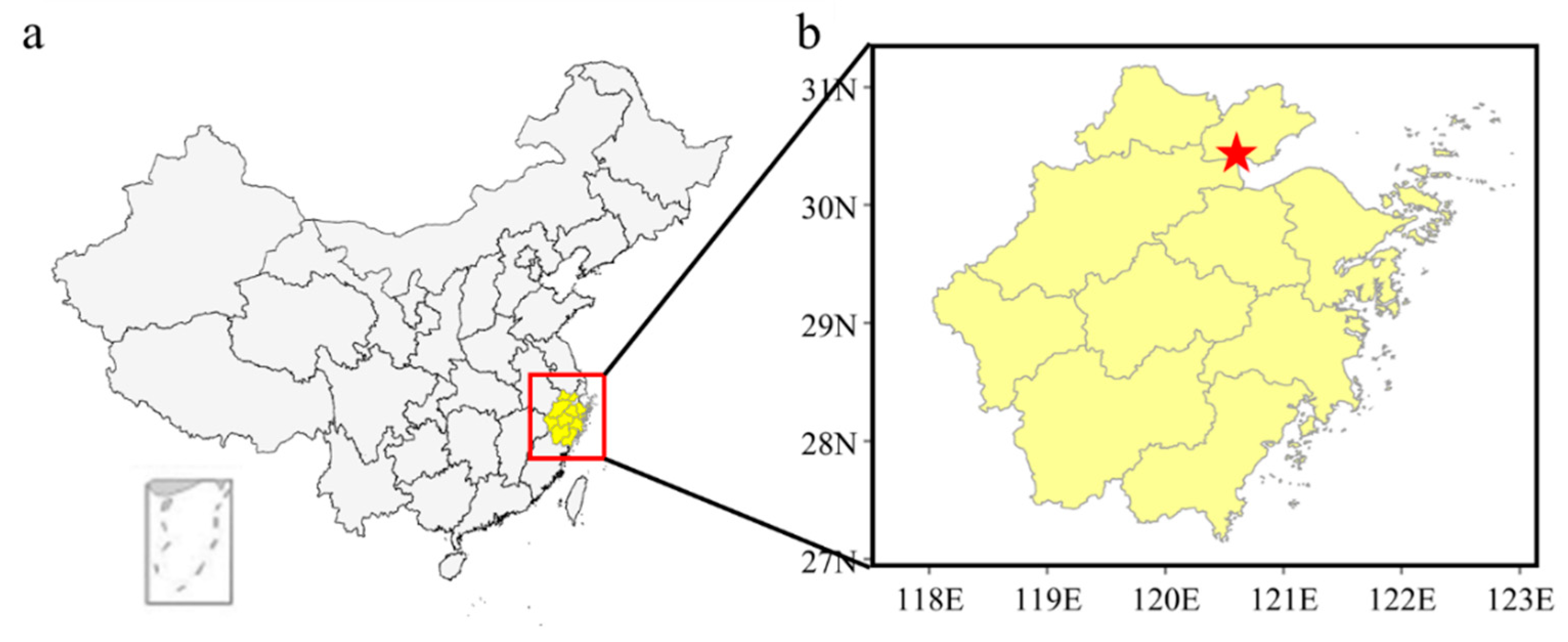
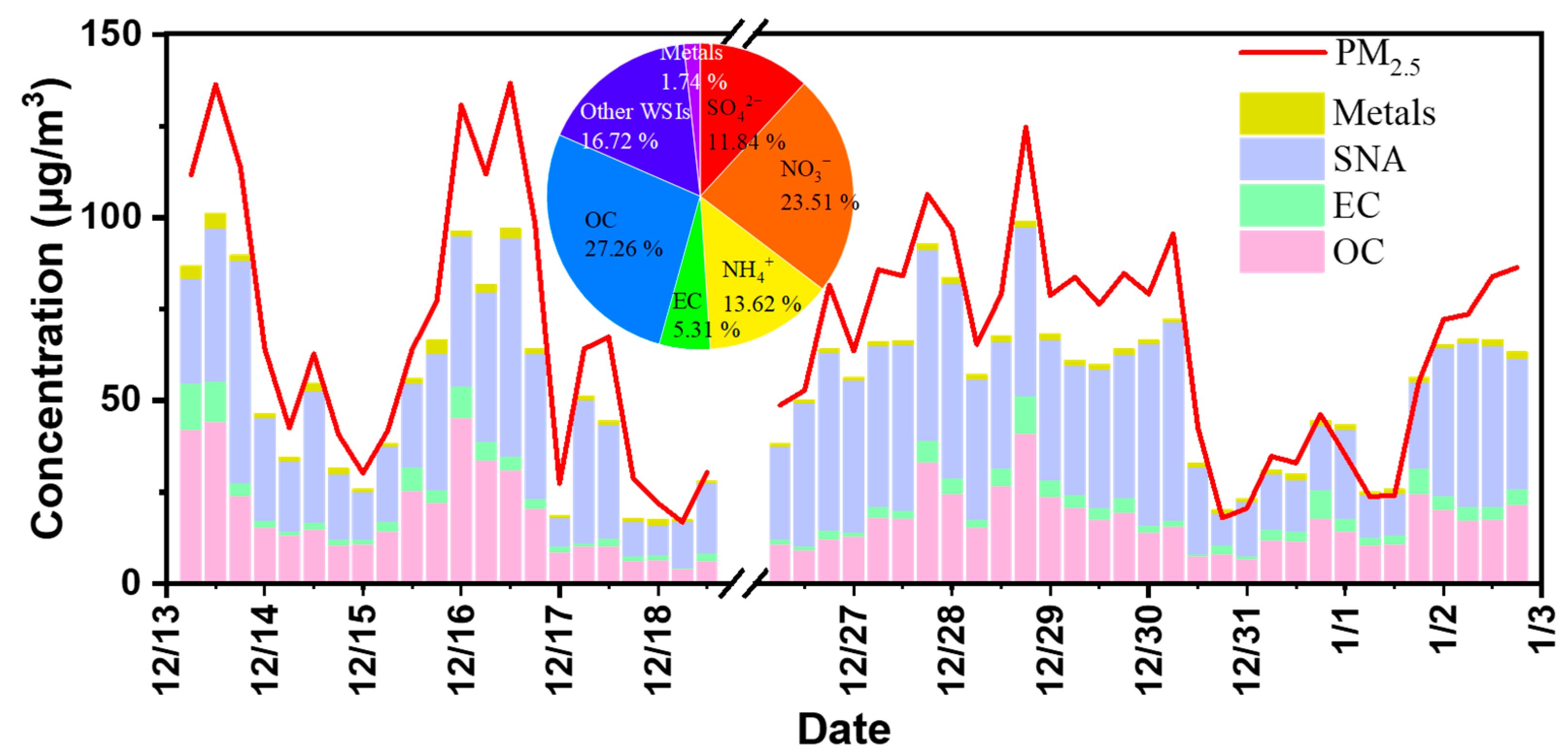

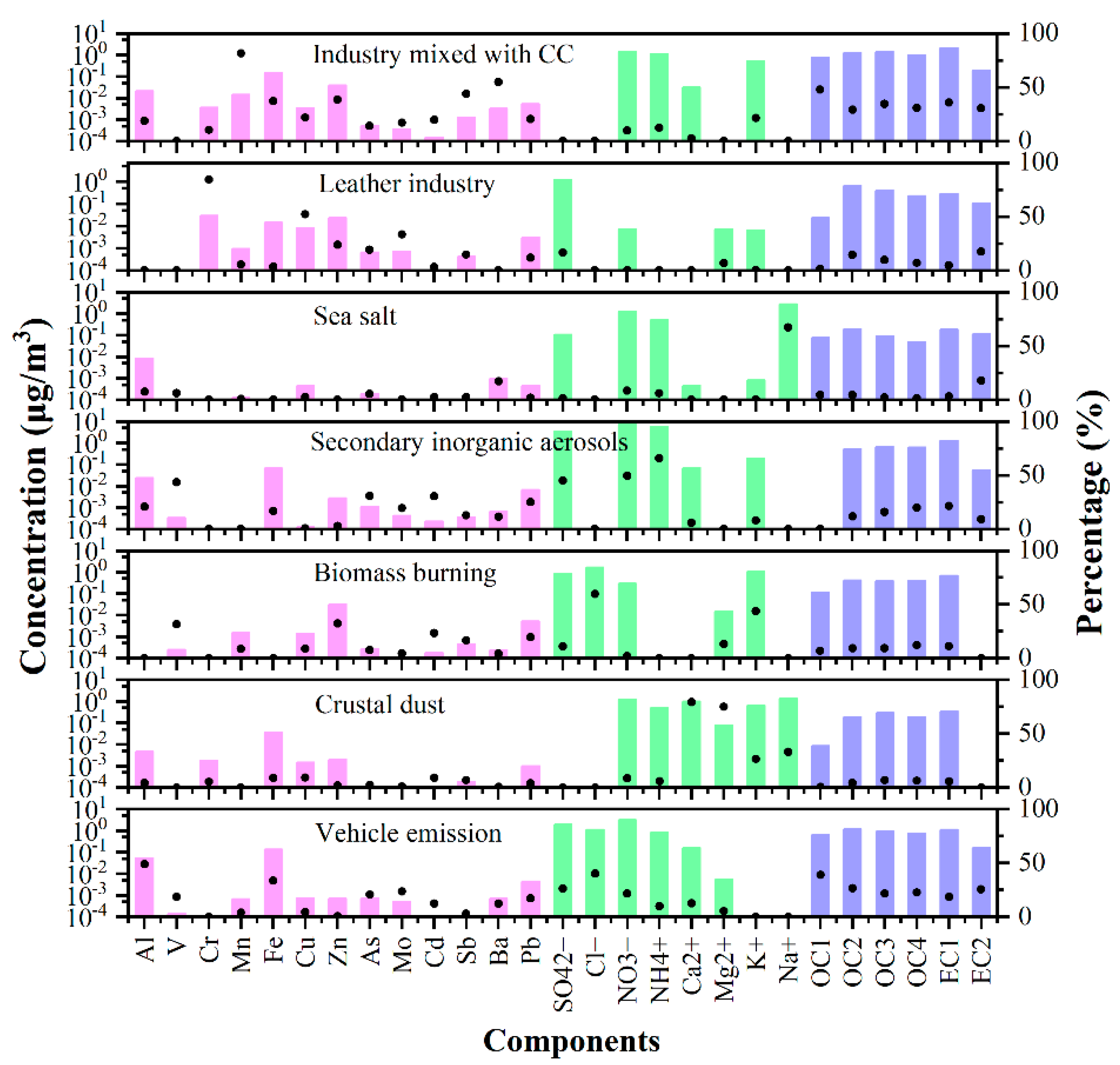
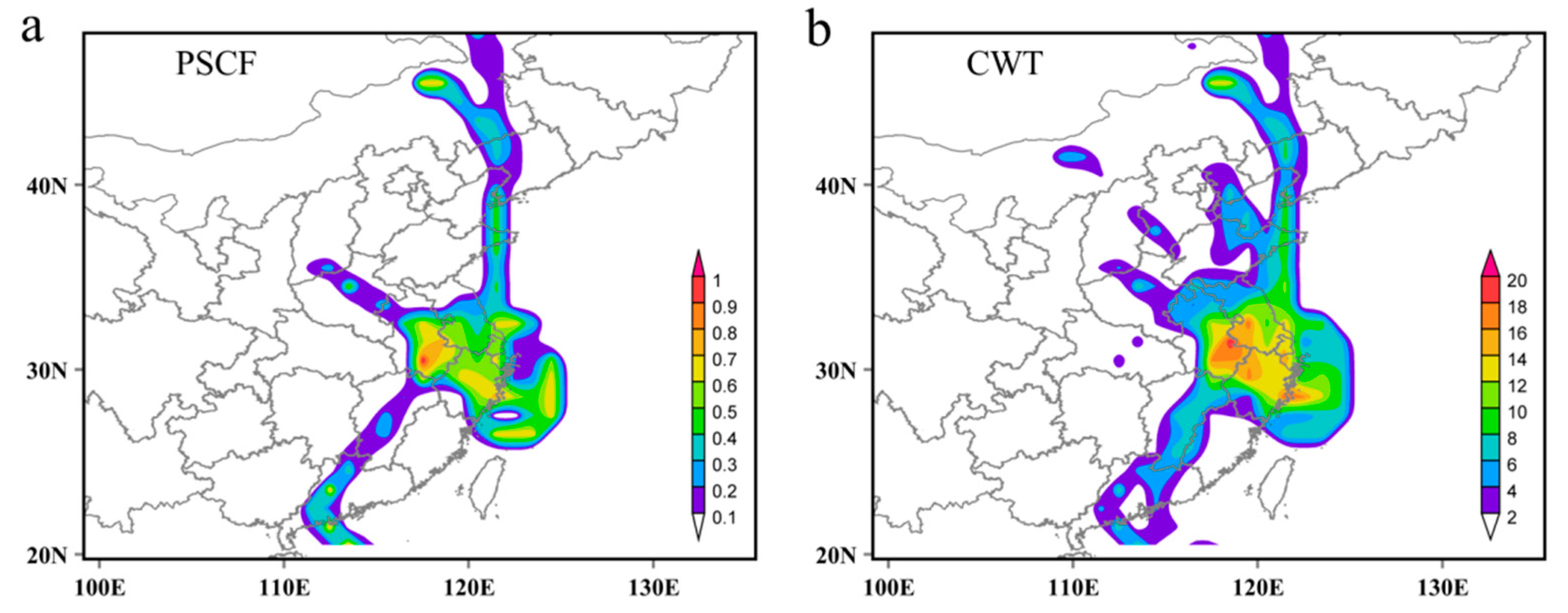
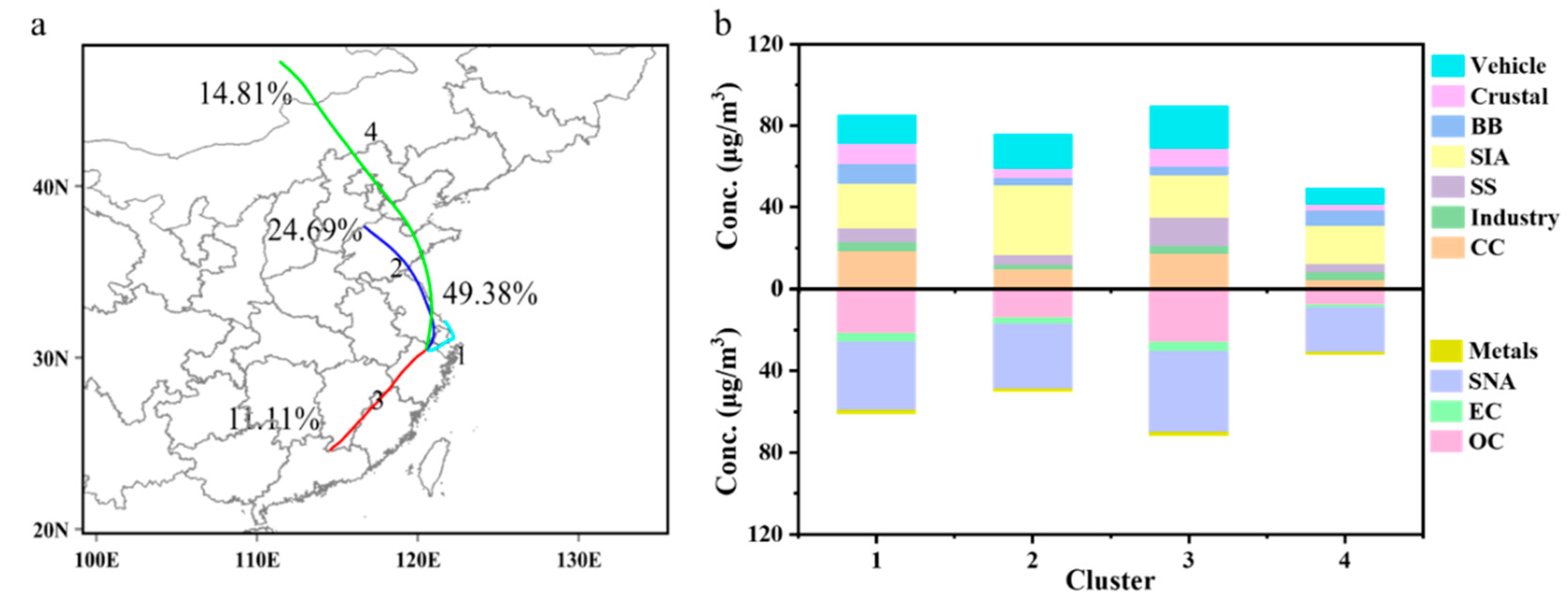
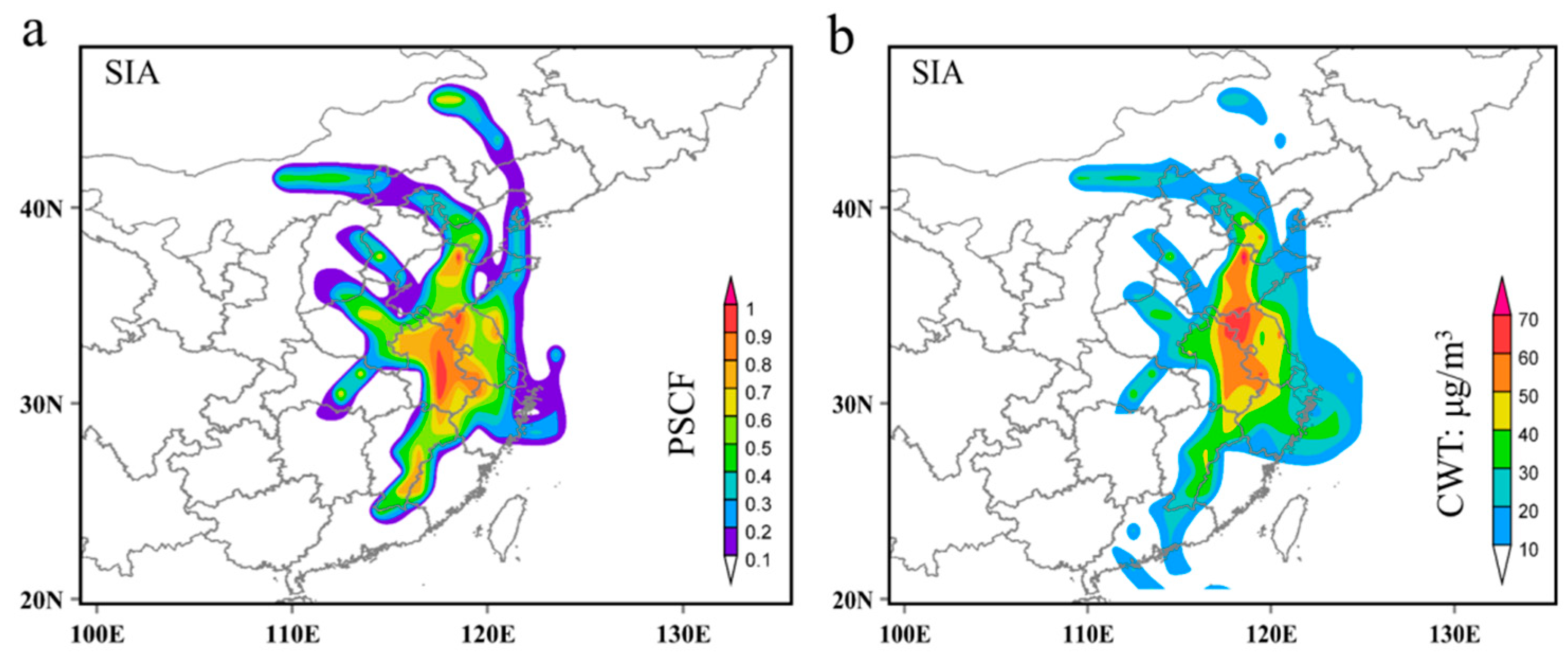
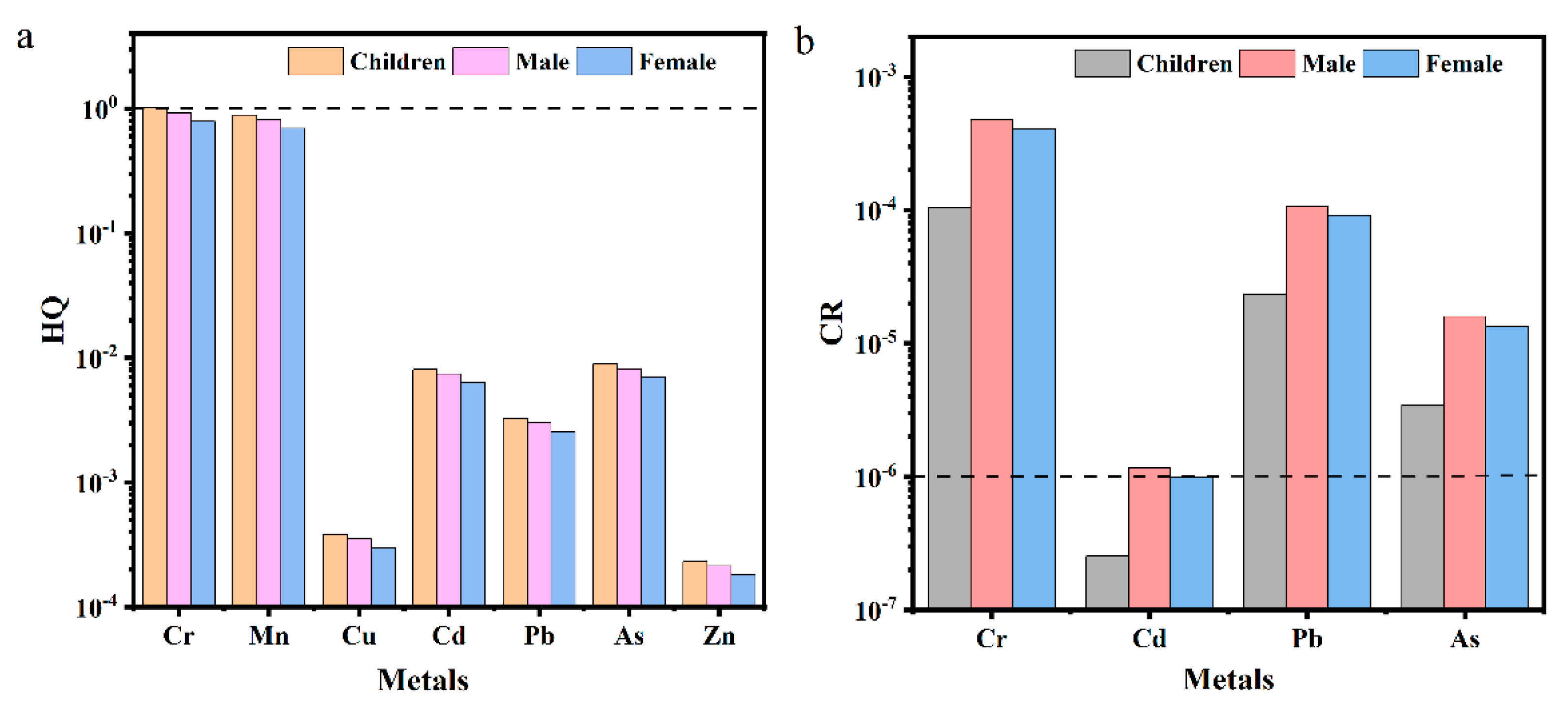
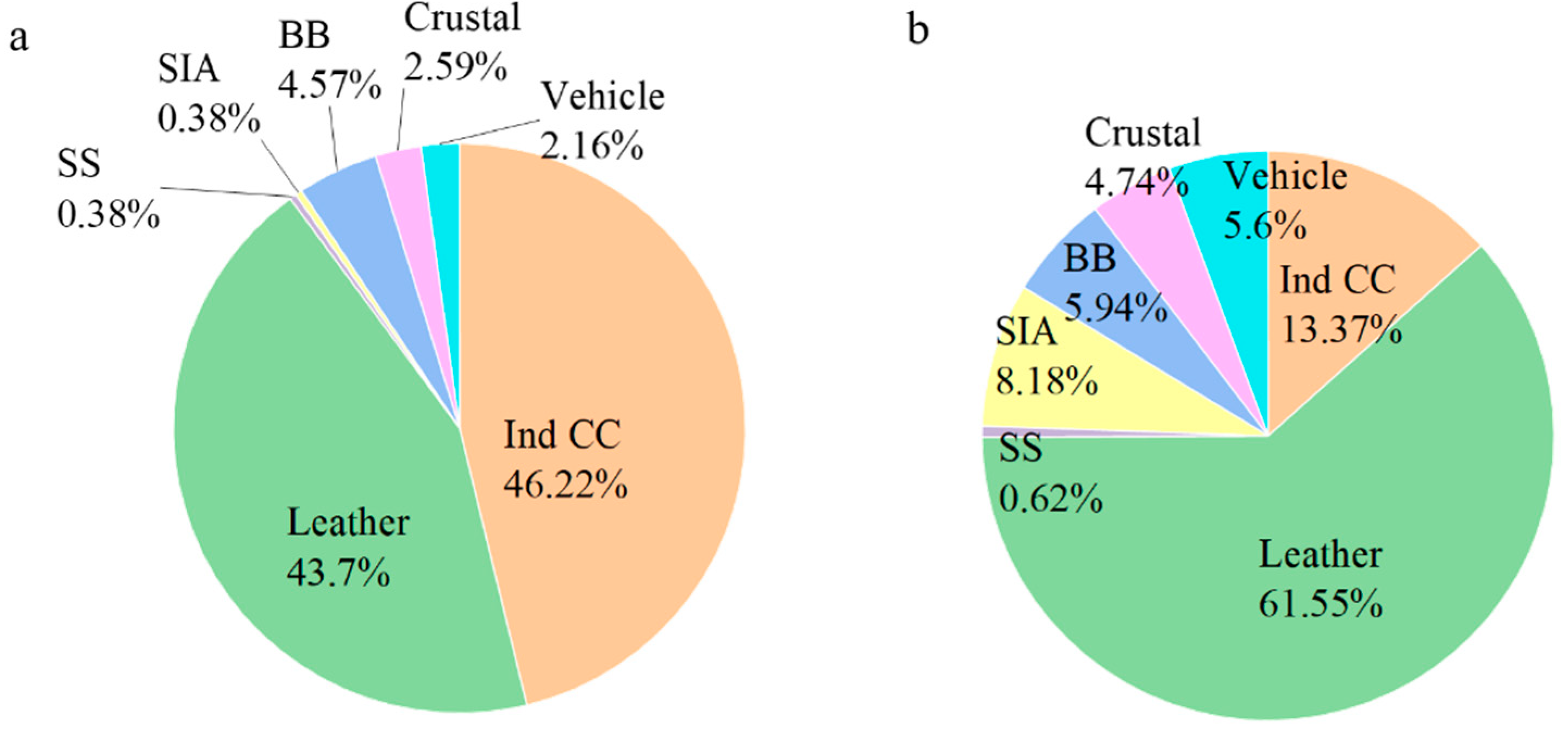
| Season | PM2.5 (µg/m3) | T (°C) | RH (%) | WS (m/s) |
|---|---|---|---|---|
| Spring | 44.67 | 17.69 | 53.08 | 2.15 |
| Summer | 23.91 | 27.84 | 57.39 | 2.38 |
| Autumn | 40.60 | 20.30 | 54.34 | 1.91 |
| Winter | 60.36 | 7.55 | 59.75 | 1.81 |
| Parameters | Units | Values | Refs. | ||
|---|---|---|---|---|---|
| Children | Adult Male | Adult Female | |||
| C, metal concentration | mg/m3 | 95%ulc | 95%ulc | 95%ulc | [36] |
| IRi, air inhalation | m3/d | 5 | 19.2 | 14.17 | [9] |
| EF, exposure frequency | d/a | 365 | 365 | 365 | [9] |
| ED, exposure years | a | 6 | 30 | 30 | [9] |
| BW, body weight | kg | 15 | 62.7 | 54.4 | [9] |
| AT, average exposure times (noncarcinogenic) | d | 2190 | 10,950 | 10,950 | [37] |
| AT, average exposure times (carcinogenic) | d | 25,550 | 25,550 | 25,550 | [37] |
Publisher’s Note: MDPI stays neutral with regard to jurisdictional claims in published maps and institutional affiliations. |
© 2022 by the authors. Licensee MDPI, Basel, Switzerland. This article is an open access article distributed under the terms and conditions of the Creative Commons Attribution (CC BY) license (https://creativecommons.org/licenses/by/4.0/).
Share and Cite
Zhang, F.; Wan, M.; Pang, X.; Yao, L.; Fu, Y.; Jiang, W.; Zhu, J.; Zhang, C. Chemical Characterization, Source Identification, and Health Risk Assessment of Atmospheric Fine Particulate Matter in Winter in Hangzhou Bay. Sustainability 2022, 14, 12175. https://doi.org/10.3390/su141912175
Zhang F, Wan M, Pang X, Yao L, Fu Y, Jiang W, Zhu J, Zhang C. Chemical Characterization, Source Identification, and Health Risk Assessment of Atmospheric Fine Particulate Matter in Winter in Hangzhou Bay. Sustainability. 2022; 14(19):12175. https://doi.org/10.3390/su141912175
Chicago/Turabian StyleZhang, Fei, Mei Wan, Xinglong Pang, Lan Yao, Yao Fu, Wenjing Jiang, Jingna Zhu, and Ciwen Zhang. 2022. "Chemical Characterization, Source Identification, and Health Risk Assessment of Atmospheric Fine Particulate Matter in Winter in Hangzhou Bay" Sustainability 14, no. 19: 12175. https://doi.org/10.3390/su141912175





